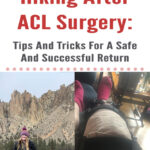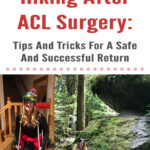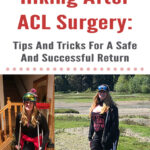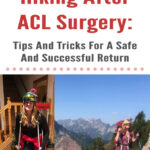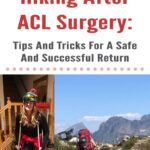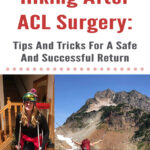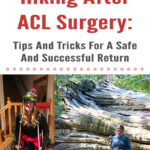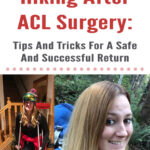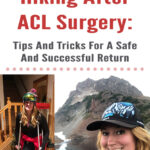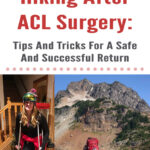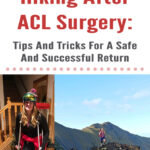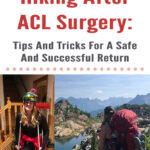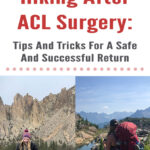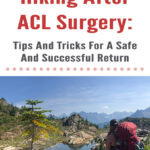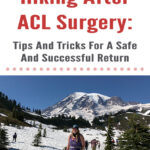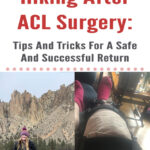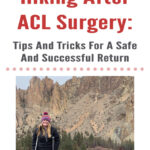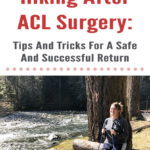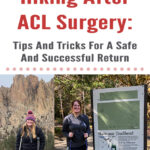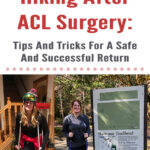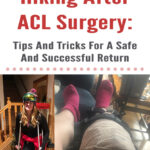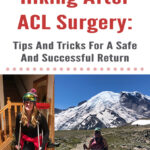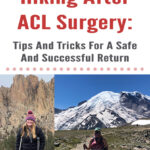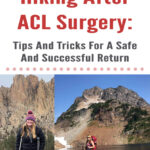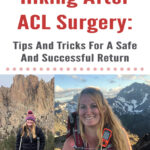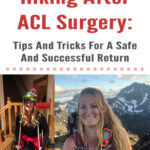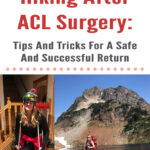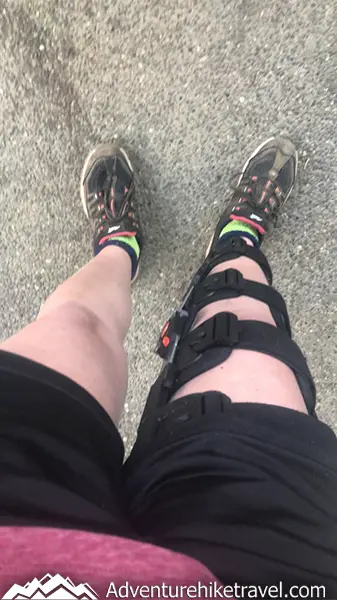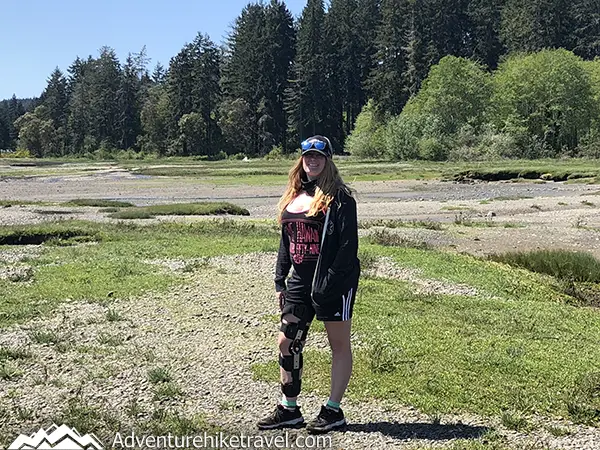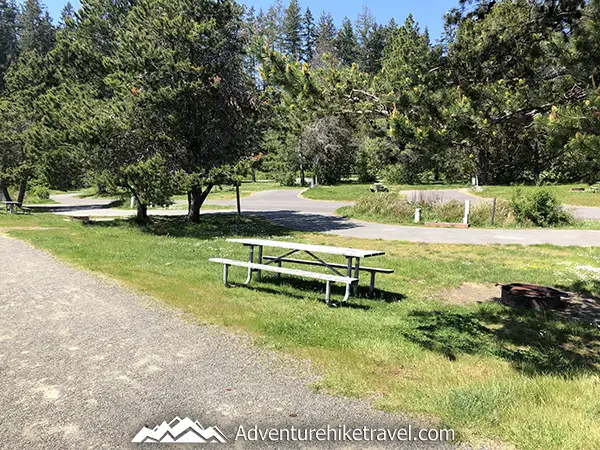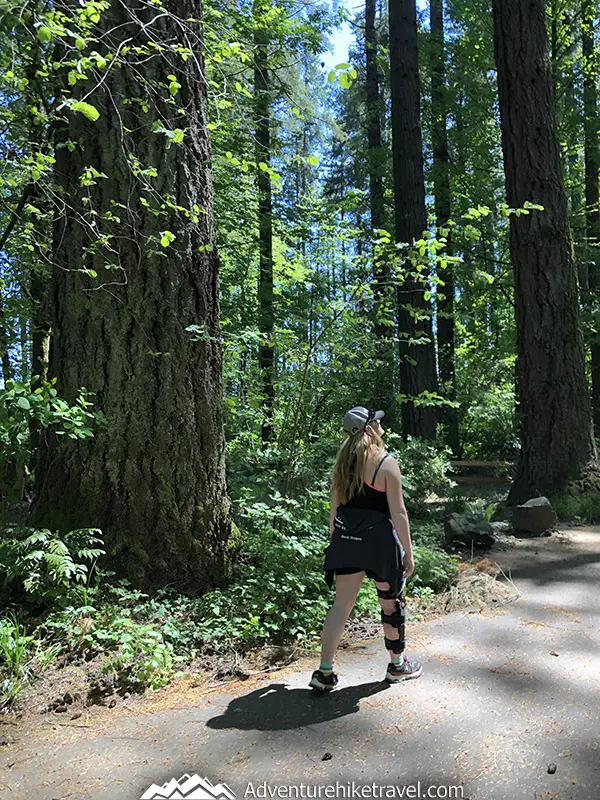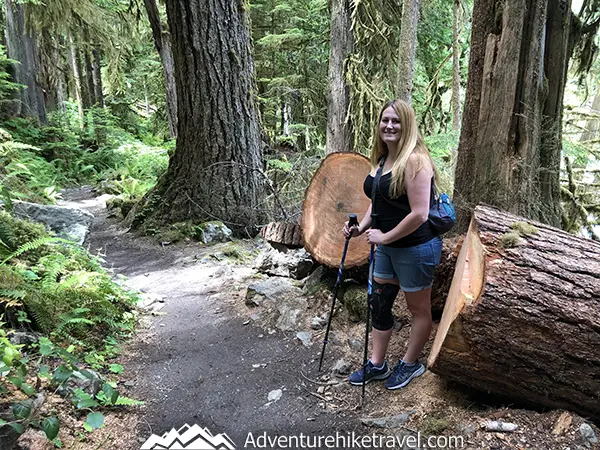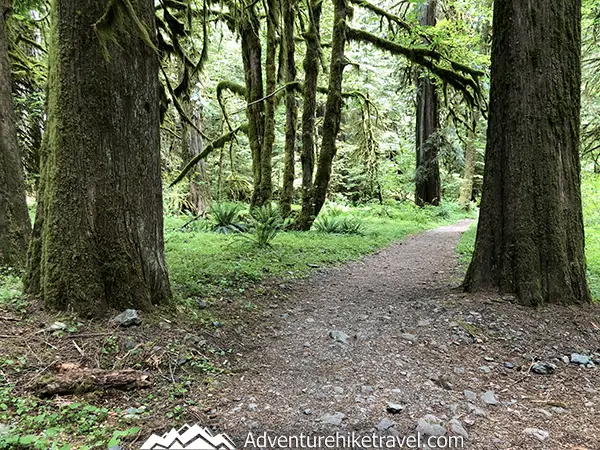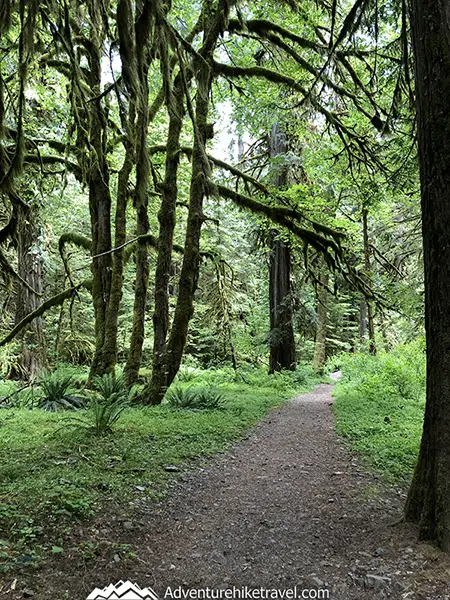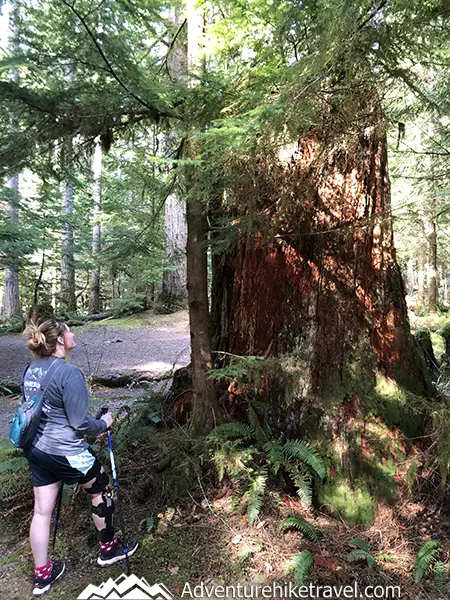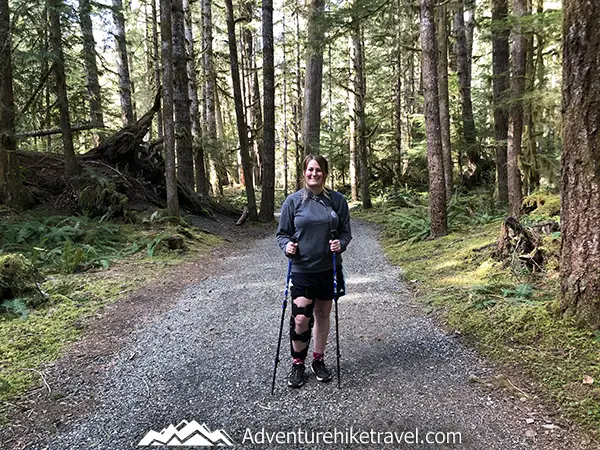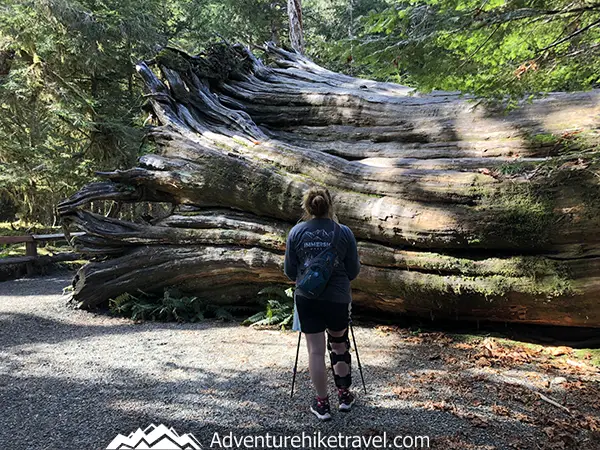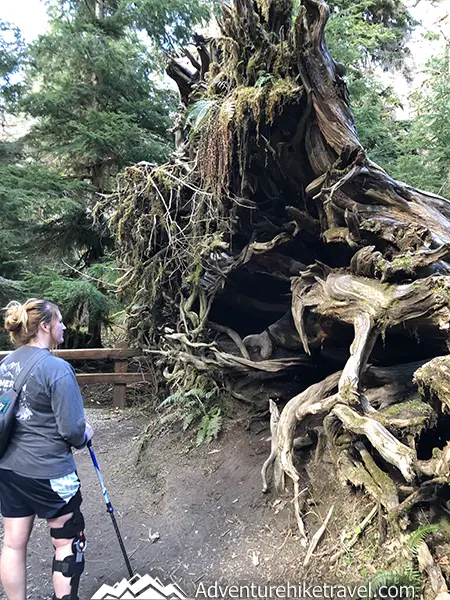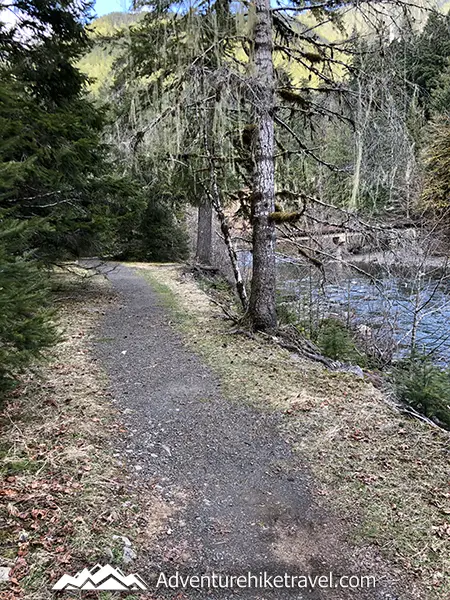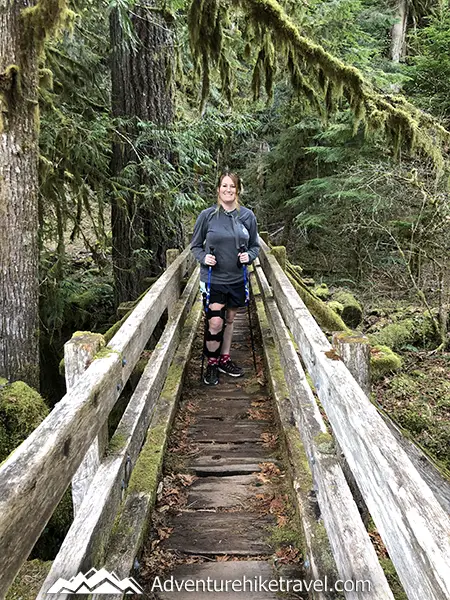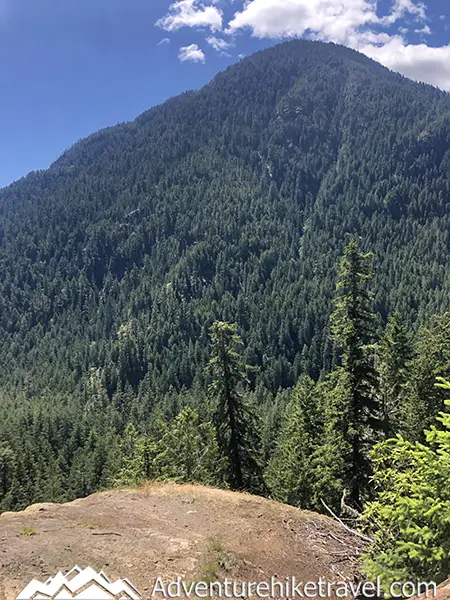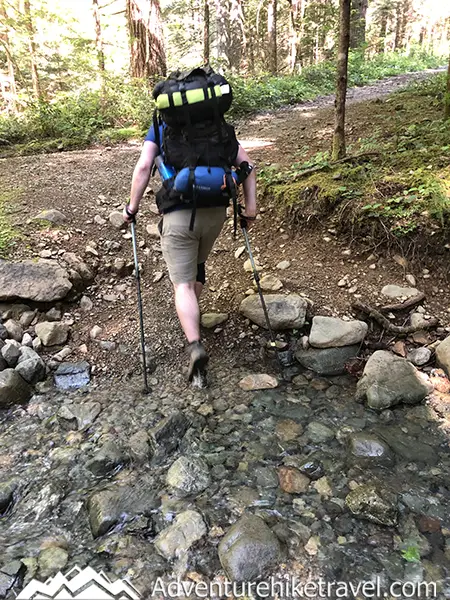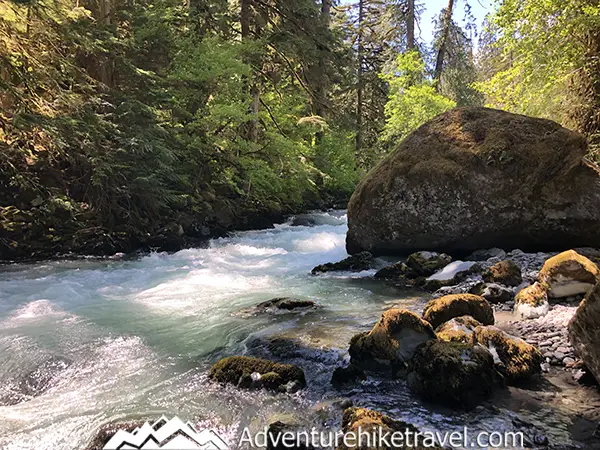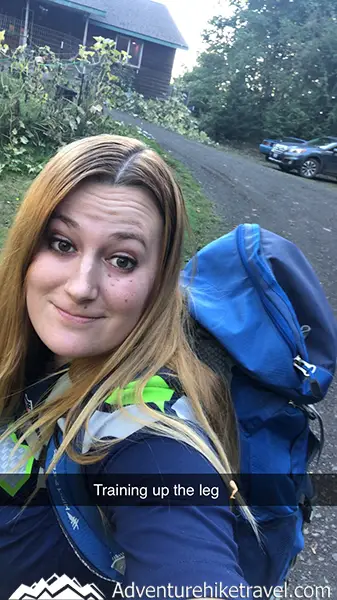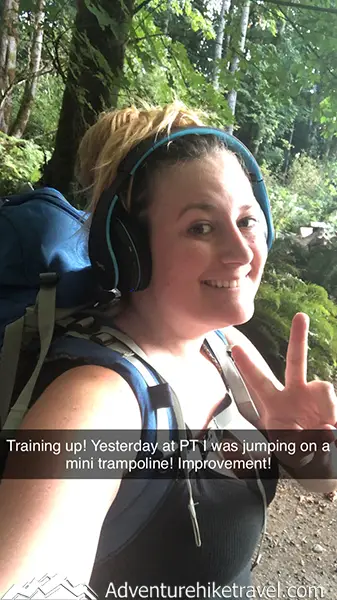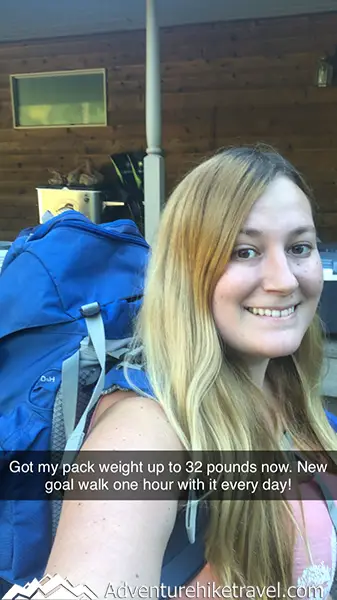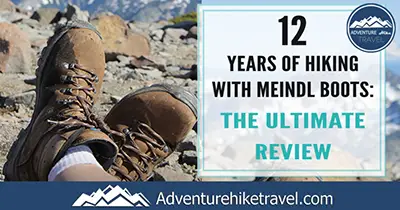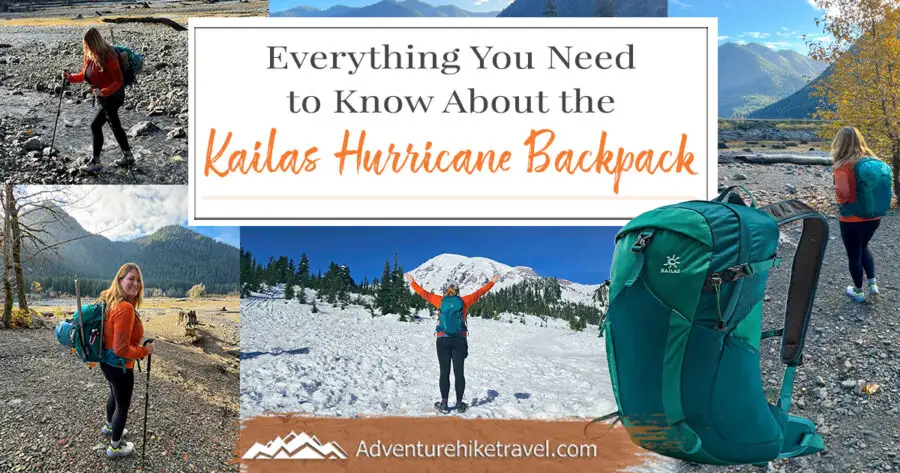Hiking After ACL Surgery: Tips And Tricks For A Safe And Successful Return
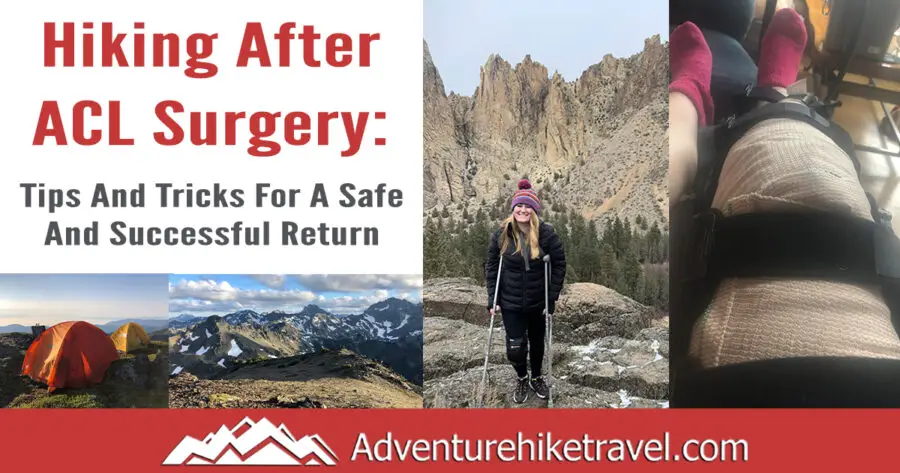
If you are an active outdoorsy person who loves going on adventures in the mountains, tearing your ACL can be absolutely devastating. Finding out that it will be months of recovery when everything you enjoy doing involves the use of your leg is definitely rough. In this blog post, Hiking After ACL Surgery: Tips And Tricks For A Safe And Successful Return, I will share my own experience of getting back onto the trail, hiking and backpacking after knee surgery, and things I learned along the way. I hope this post inspires and helps you with your own journey of getting back into the mountains after knee surgery.
Disclaimer: I am not a medical professional and I am not giving you medical advice. I am just a girl who tore her ACL and I am sharing my own personal journey and experience from healing from ACL surgery. I also include tips that helped me and my brother who also tore his ACL, four months after I tore mine, get back to hiking and backpacking. No two injuries are the same and for any medical questions, it is best to consult your doctor or physical therapist.
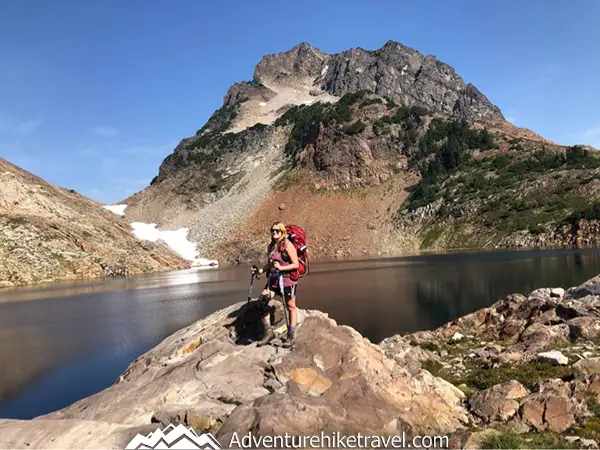
When Can You Hike After ACL Surgery?
Are you eager to get back to hiking on trails again after undergoing ACL surgery?
Unfortunately, you may have to wait a while before doing so. In general, most people will need to wait at least six to nine months before attempting to hike strenuous or difficult trails again after ACL surgery.
However, this timeline can vary depending on individual factors such as age, fitness level, and the type of surgical procedure performed. Under your physical therapist's and doctors' guidance, it is possible to hike small flat trails during your whole recovery to work up to the bigger trails when your knee is more healed after 6-9 months. It's crucial to consult with your doctor and physical therapists before returning to any physical activity to ensure that your knee has fully healed and is strong enough to handle the demands of hiking.
Physical therapy is critical to regaining strength, mobility, and range of motion in your knee. To ensure the best possible outcome, and get you back to hiking as soon as possible, it's essential to follow your physical therapist's instructions carefully and complete all recommended exercises. I worked with my physical therapists and incorporated flat easy hikes as a part of my recovery process. We gradually increased hike duration and elevation but It wasn't till the 6-month mark till I did any trail with over 500 feet of elevation gain. Just be careful overdoing things too soon can lead to setbacks and prolong your recovery. Remember, patience and consistency are key to a safe and successful return to hiking after ACL surgery.
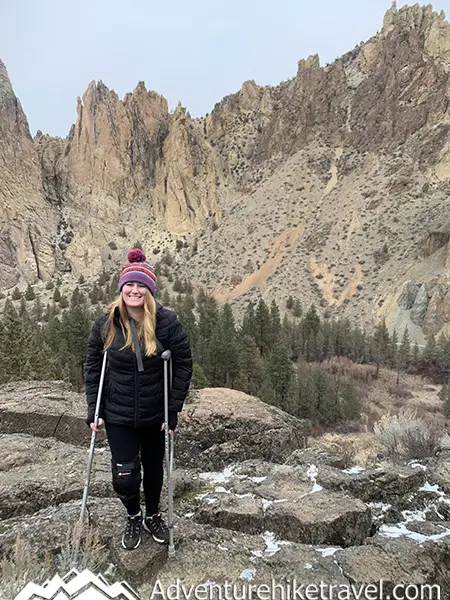
My ACL Story
On December 14th of 2019, I was excited to spend a day in the mountains snowboarding on a beautiful bluebird day at our local ski resort Crystal Mountain in Washington state. Little did I know that I was soon going to be requiring surgery, months of hard work doing physical therapy and working on getting back to a point of being able to walk again pain-free, and even more months of work to return back to all the activities that I love doing.
After a full day of snowboarding doing lap after lap with almost no lines, around 2:30 pm my brother and I decided that our legs were fatigued and we should start heading down the mountain and call it a day. At the top of Green Valley, before heading down to the bottom of Crystal Mountain, I crashed. I heard a loud Pop-Pop sound in my right knee. I scooched on my butt out of the way for some other people, stunned for a moment, thinking okay let me shake this off. I tried to stand up and immediately collapsed. I unstrapped from my snowboard and tried to wait a few minutes and tried to stand up again only to feel white hot pain shoot up my leg. Before I could even comprehend what happened, my knee buckled and I was on my butt in the snow. I could put zero weight on my right leg at all. I realized something was seriously wrong.
Ski Patrol came to the rescue and got me down the mountain. They got my snowboard boot off, did some tests, and told me to see a doctor and get some X-rays Monday morning. Ski Patrol wrapped my leg up in bubble wrap, tape, and cardboard to immobilize it enough to get me home. My brother got me some crutches from a Rite Aid along-the-way while driving me home so I could walk when getting out of the car.
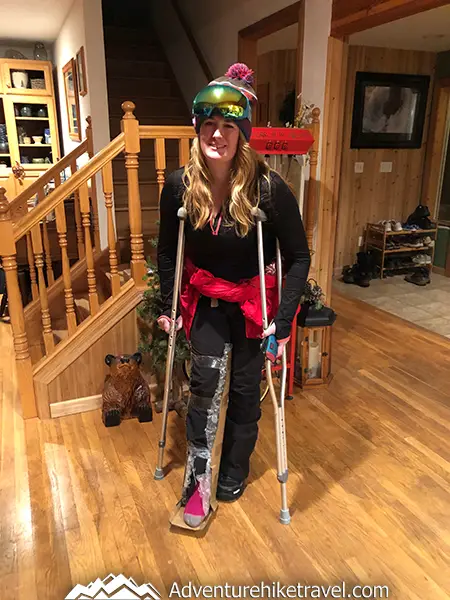
Photo My Mom took of Me When I Got Home.
Fast forward a bit, my knee swelled up like a balloon and I began the process of seeing doctors, getting X-rays then MRIs, setting up Physical Therapy then getting a Surgery Date for February 12th of 2020. Yep, the MRI results concluded that I completely tore my ACL and received 3 times the amount of bone damage from the force of my femur impacting my tibia bone. I was going to need surgery to get back to doing all the activities I loved doing, such as snowboarding, hiking, riding my horse, and rock climbing.
I was on crutches all the way up until a few days before my surgery for my ACL and then was back on crutches again after surgery for a few more weeks. The extreme about of bone damage was the primary reason I could not put any weight on my leg for months even before getting surgery for my ACL. Due to months of being on crutches my healing time was a little bit slower than some people's recovery time but I was still able to return to most of my sports after 6 months. Day hiking 8+ miles, riding my horse rock climbing, and other sports that were not as high impact on my newly healed knee. I still had to be extremely careful and wore a brace while doing these sports but at 6 months I was starting to feel a lot more like normal again.
For some sports like snowboarding, and backpacking, I needed a bit more time for knee rehabilitation. It took 12+ months before I went snowboarding and backpacking again after ACL surgery. Snowboarding, backpacking, hiking over more rugged terrain, summiting mountain peaks, doing over 5,000 feet of elevation in a day, and scrambling over boulder fields while carrying a 45-pound pack before 12 months, would have been too dangerous. I felt like my knee needed the full 12 months to heal up before taking on more aggressive activities like that.
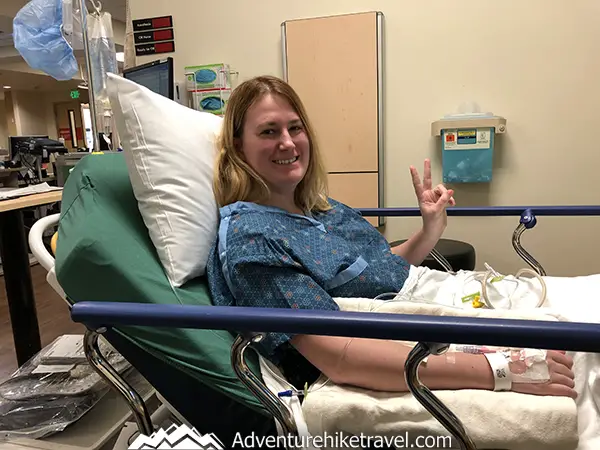
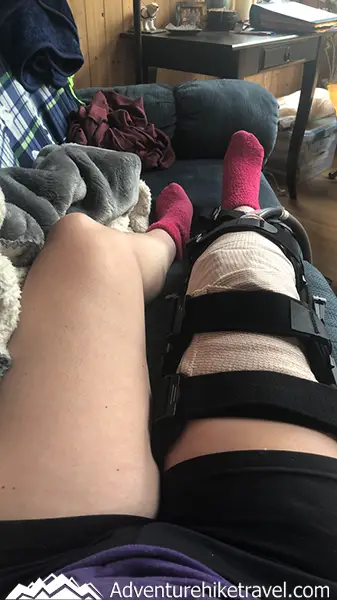
Preparing For Hiking After ACL Surgery
Returning to hiking after ACL surgery can be both exciting and daunting. While it's important to take it slow and listen to your body, doctors, and physical therapists, it's possible to incorporate being outdoors into your ACL healing journey. Hiking on flat trails can be a great way to get back into outdoor activities and enjoy nature while training up for the bigger hikes you may be itching to get back to. However, it's essential to take certain precautions and prepare properly to ensure a safe and successful return. In this blog post, we'll explore some tips and tricks, and experiences I learned along the way recovering from my own ACL injury. We will go over preparing your body, using the right equipment, and hiking techniques. Whether you're a seasoned hiker or new to the trail, I hope that these tips will help you stay safe and help you get back to the trail after ACL surgery.
Knee Rehabilitation After ACL Surgery: The Road to Recovery Begins
After having surgery on my ACL in February of 2019 I had my work cut out for me to try and rehab my knee enough to get some summer hikes in. Since my snowboarding season was over, my new goal was to rehab my knee in time to be able to do some summer hiking.
Do All of Your Physical Therapy Exercises Everyday No Matter How Simple or Silly They May Seem
Some of the Physical Therapy exercises may seem too basic, simple, or boring. You may be wondering "Why do my physical therapists want me to press my leg down on a rolled-up towel"? Maybe you feel that you do not have time to fit all your physical therapy exercises into your schedule when your physical therapists begin to assign more and more exercises to do each day. But doing these exercises are essential to your recovery. You might not feel like doing them. Don't Skip!!! Your physical therapy routine was given to you for a reason. Sometimes other muscles in other areas become unbalanced and it is critical to keep up with your daily exercises. If you are busy you have to make time for your physical therapy routine. The one thing I heard from other people who had torn their ACL is that if they could do things over again, they wish they had taken their physical therapy exercises more seriously. By slacking off they didn't heal properly.
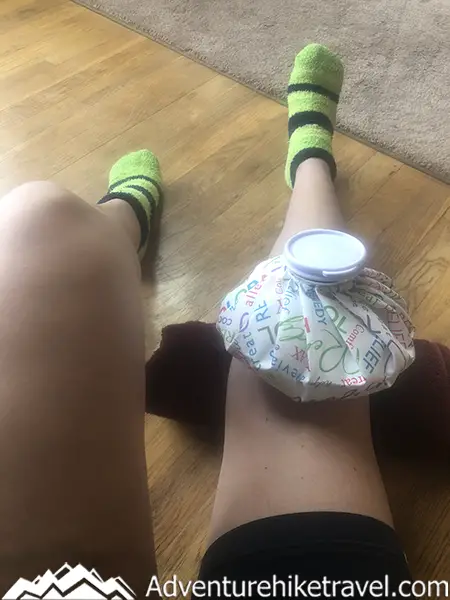
If You Are Able To Try And Borrow or Purchase Workout Equipment To Help Aid in Your ACL Recovery
To help you regain strength and flexibility in your knee, in addition to going to physical therapy, try and borrow or purchase some workout equipment to help aid your ACL recovery. Having a few simple tools at home are a great way to keep working on improving your range of motion, agility, and muscle strength. Doing all your physical therapy exercises and having some of your own equipment to use at home definitely helps you do everything in your power to rehab your knee as quickly as possible to get you back to hitting the trails.
Shop on Amazon:
Shop on Amazon:
Shop on Amazon:
Shop on Amazon:
Use A Stationary Bike To Help in Your ACL Recovery
One of the first exercises my physical therapist started me on after ACL surgery was the stationary bike. Riding a stationary bike is an excellent way to improve your range of motion, increase your muscle strength and improve your cardiovascular fitness. When trying to pedal the stationary bicycle back and forth, one week after surgery, I could not make a full rotation and I burst into tears. How could something so easy be so incredibly hard?
I was determined to work overtime to improve my range of motion.
I did not have the money to buy my own expensive stationary bike but I was able to buy a Bike Trainer Stand to turn my mountain bike into Stationary Bicycle. Click Here To Shop on Amazon. Using a stationary bike daily to do my range-of-motion exercises was a massive benefit. I worked every day to improve my range of motion after ACL surgery and when I finally succeeded and was able to complete a full rotation with the bike pedals. This was a huge victory and soon I kept being able to pedal more rotations on the bicycle and completing full rotations started becoming easier and easier as time went on.
From then on it became less about gaining range of motion and more about increasing muscle strength in all the muscles that support the knee. By increasing the resistance on the bike and increasing my ride time each day I could finally start working on rebuilding strength in my muscles that had massively atrophied during my months of being on crutches.
If You Are a Hiker Who Wants to Get Back to Hiking After ACL Surgery I Cannot Recommend Using a Stationary Bike Enough. I believe using the stationary bike really helped me with my ACL recovery and helped me get back on the trail faster.
Quick Tip: To avoid getting bored on the stationary bike, listen to some podcasts or music.
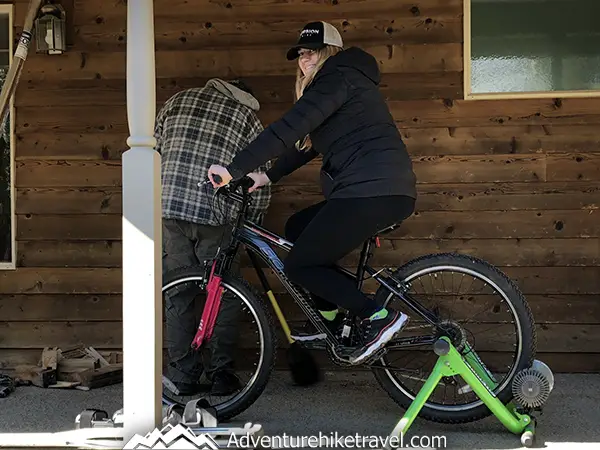
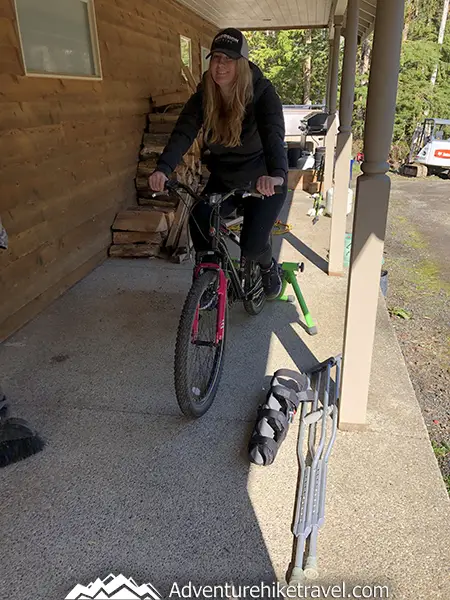
Keep Asking Your Doctor and Physical Therapists Questions
I asked my physical therapists and doctors tons of questions about when can I do this or that again. What exercises can I do at the moment? What extra exercises can I do to help me achieve my goals of getting back to hiking, snowboarding, and other sports as soon as possible? By asking lots of questions about additional exercises I could do, they gave me additional stuff I could work on to improve faster. From extra wobble board exercises to movements that I will need to get back to snowboarding and hiking, asking additional questions and keeping your doctors and physical therapist in on your end goals helps.
My physical therapist encouraged me to walk as much as I was able to. The first few months they advised that I be extra careful during months 2-3 when my new ACL would be at its weakest, they told me to stick to flat ground. My physical therapists and doctors recommended that I stick to relatively flat trails, gravel, concrete, and solid dirt, and avoid trails that are muddy, and have a lot of inclines or roots/other tripping hazards till later on. After my new ACL got stronger I could attempt pushing myself a bit more.
To Start Hiking After Knee Surgery Begin With Simple Hikes
Hiking After ACL Surgery Tip: Take This Time To Explore all the Flat Easy Trails Around Your Area
I started out walking with my crutches on some paved trails overlooking a river that was at a local state park just 15 days after my ACL surgery. I did not go far and after just a little bit of walking with my crutches, I was pretty exhausted, sore, and in pain, but it was a good start.
I kept walking each day and continued finding easy flat trails with little to no elevation and kept increasing how long I could walk. Some trails were boardwalks, some were flat dirt paths through the forest and others were maintained flat gravel trails along rivers. As someone who normally seeks out the more challenging trails, I took this time during my ACL recovery to explore all the easy flat trails that are around me.
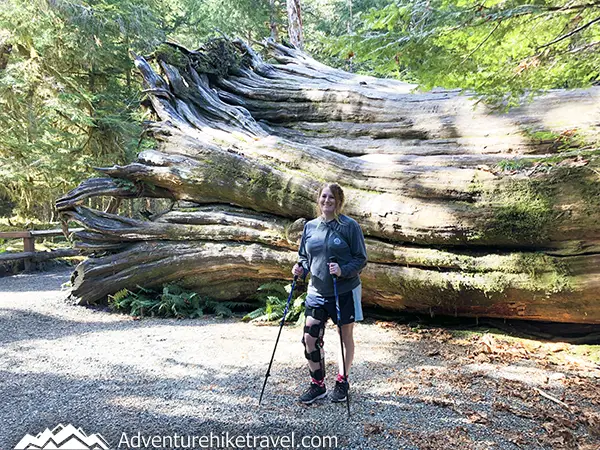
Gradually Increase The Difficulty Of Your Hikes
1-2 months after ACL surgery I was strictly on flat ground only. Walking with crutches on flat ground then graduating to walking with trekking poles on flat ground. Trails with 0 elevation gain and 0 tripping hazards and I would hike less than a mile. Basically, a stroll through the woods or on flat concrete or boardwalks overlooking views. At this stage, I was still in a lot of pain and needed lots of rest and ice. I talked with my doctors and physical therapists every step of the way and kept them updated on what flat walks I was doing and how long I would walk and how my knee felt after each walk.
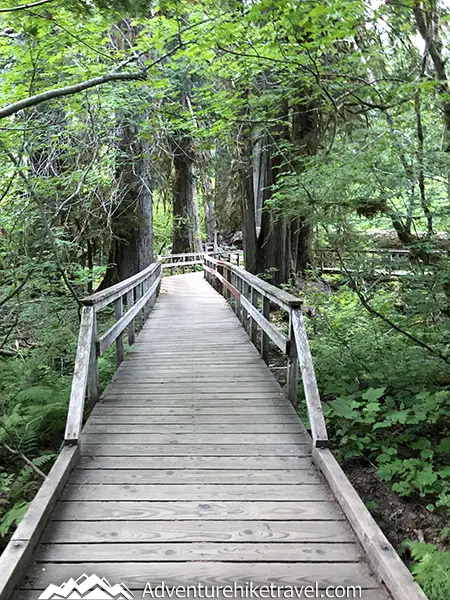
2 -3 months after knee surgery I hiked part way up the Staircase Rapids Trail in Olympic National Park. I did maybe a quarter mile and turned around when the trail started getting a little more rooty and started having an incline. I promised my doctors and physical therapists if the trail started getting uneven I would turn around. Do not push your knee when it is in its most fragile stage of rebuilding. Typically after ACL surgery, the new ACL graft is the most fragile during the first 6 to 8 weeks of healing. During this time period, the graft is still in the process of integrating with the surrounding tissue and developing new blood vessels.
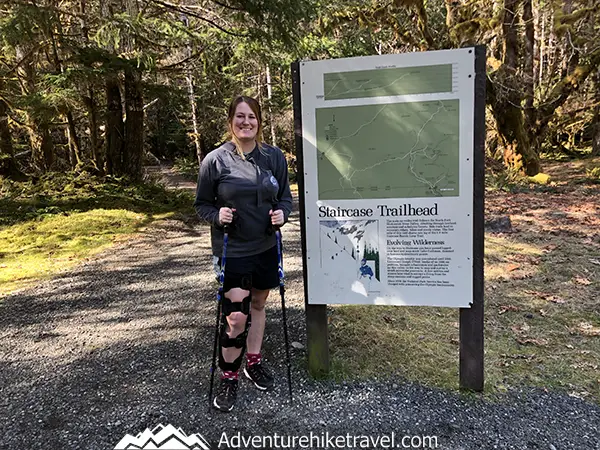
4 months after having my ACL knee surgery I started being able to hike the full 2-mile-long Staircase Rapids Trail in Olympic National Park which has 574 feet of elevation gain. I did this 2-mile loop several times during months 4 and 5 and was able to drastically improve my hiking time each time I went. The first time I completed the loop I was walking at turtle speed and It took a lot of work and was definitely in some pain after my hike. Each time that I went my hiking speed increased, I needed fewer breaks, and did not have as much swelling or pain in the knee afterward.

5 months after having knee surgery I did some easy trails at Paradise Mt. Rainier. I hiked to Myrtal Falls and a little bit around the Paradise visitor center and did the grove of the Patriarchs Trail. I did about 4 miles with some elevation gain but not a lot. During this time period of my ACL recovery, the focus of rehab shifted more towards regaining strength, balance, and coordination, as well as improving cardiovascular fitness. My doctors and physical therapists encouraged me to work on rebuilding my leg strength while still being careful.
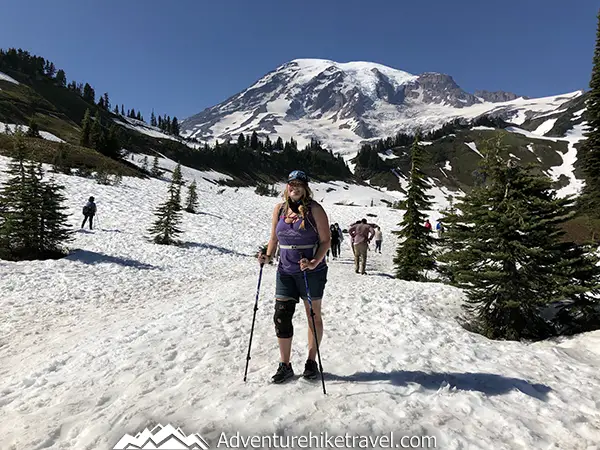
6 months after my ACL surgery I received the go-ahead to start hiking on trails that were more strenuous with elevation. My doctor told me just avoid boulder fields and any trail that has unstable soil where I could slip or have lots of tree roots. My first real hiking adventure after my knee surgery was to Second Burroughs at Mt. Rainier National Park. I did 7.71 miles with 1,336 feet of elevation gain to hike Second Burroughs in 6 hours and 59 minutes which includes numerous breaks and stopping for lunch. I was absolutely exhausted and sore afterward but this was a major accomplishment. I did my first real hike!

9 months after my knee surgery I was taking on 9 miles + trails with 3,000 feet of Elevation Gain. I Hiked Mt. Townsand, Mt Elinor, and Part Way up to Upper Lena Lake. By month 9 after ACL surgery I was finally starting to feel like myself again. I was not having the pain levels that I had in months 6-7 after my hikes. I had some slight swelling after these tougher hikes but nothing bad. Going uphill was great it was primarily the downhill that was bothering me.
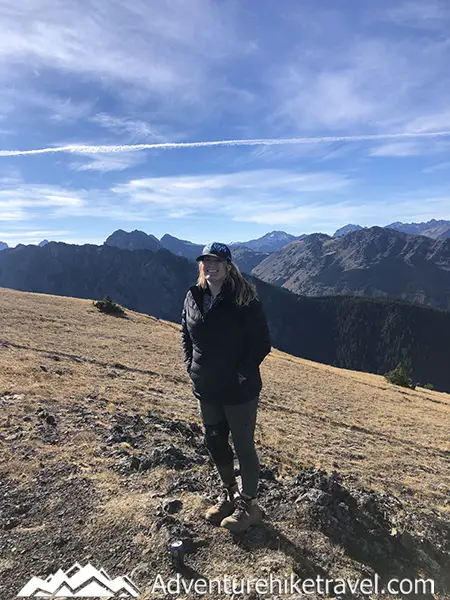
First Backpacking Trip After ACL Surgery
16 months after ACL surgery I set out on my first backpacking trip after having ACL reconstruction. I went with my brother who tore his ACL dirt-biking four months after I tore mine snowboarding. So this backpacking trip was the first backpacking trip after ACL reconstructive surgery for both me and my brother.
We decided on something easy to see how we did with full pack weight. We chose the Duckabush River Trail in Washington State to Five Mile Camp. 5 miles in 5 miles out making for a 10-mile trek. My pack was 44 pounds with water and food. My knee felt pretty solid and both my brother and I were pretty excited for the rest of the backpacking season after having a successful first backpacking trip after ACL surgery. We both only had a little swelling in the knee but after icing our legs in the ice-cold Duckabush River we felt pretty good.
By this time on most day hikes, we wouldn't wear the knee brace but with the heavy pack weight on a backpacking trip, we both decided to wear our knee braces for extra support while backpacking.
Backpacking Up Mountains and Rough Terrain Again After ACL Surgery
17 months after ACL surgery for me, and I think about 12 months post-ACL surgery for my brother, we felt that our knees were ready to take on more extreme trails again. We decided to go backpacking to Goat Lake and Mt. Petunia in Olympic National Park. Backpacking to Goat Lake and Mt. Petunia is about a 12-13 mile round trip with about 4,498 plus feet of elevation gain over some rugged terrain.
Summiting Mt. Petunia, we went over some boulder and scree fields that there is no way I would have felt ready for the year before. The trail to Goat Lake was almost a straight shot up from the Upper Dungeness River gaining nearly 3000 feet of elevation in 2 miles. This was rough, we were wishing for switchbacks. My brother and I did this backpacking trip, and our knees did pretty well with only a little pain. On the way back down, my brother who was a few months behind me with his ACL recovery, had a lot more knee pain on the way down but after a day of rest and ice when he got home, he was fine. Our knees felt very solid even walking over trees and climbing over boulders. After this hike, I felt confident in my ability to tackle any trail again. The main thing holding me back was just my overall fitness level due to the long knee recovery. But my knee was feeling great!

Use Trekking Poles For Increased Stability After ACL Reconstruction
Trekking poles are absolutely amazing!!! Trekking poles helped me out a ton when I got back to hiking after ACL surgery. Trekking poles provide increased stability and support for the knee joint, helping to reduce the impact on the injured knee during hiking. Using trekking poles can also help distribute the weight more evenly throughout the body, which can reduce the load on the knee joint.
Trekking poles can be especially helpful during uphill and downhill portions of the trail, where the knee joint is most susceptible to injury. Probably the scariest bit of going back to hiking after an ACL injury is going downhill and having trekking poles definitely helps. Trekking poles are an invaluable tool for hikers returning to the trail after ACL reconstruction surgery.
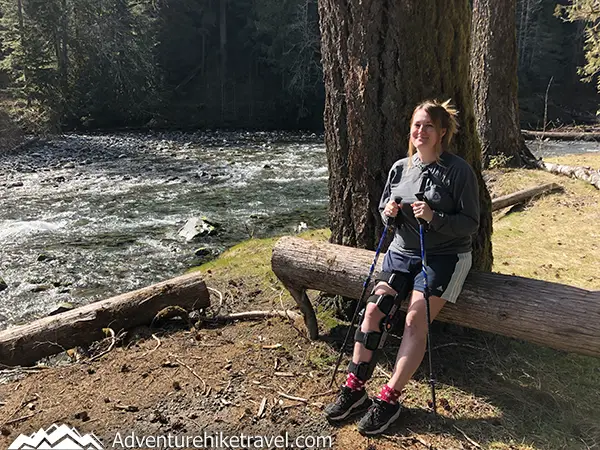
Use A Knee Brace to Help Stabilize the Knee When Hiking
When your doctor and physical therapists allow you to start hiking again after ACL surgery you should start out with a good knee brace. A knee brace is an awesome tool for hikers returning to the trail after ACL reconstruction surgery. Knee braces help stabilize the knee joint, and provide additional support during the hike, and helps reduce the risk of re-injury.
Knee braces come in many different types and styles, so it's important to consult with a healthcare provider to determine which type of brace is best for your specific needs. A knee brace may also help alleviate pain and discomfort during the hike. It's important to note that a knee brace should not be used as a substitute for proper rehabilitation exercises and caution on the trail. However, when used in combination with other strategies, a knee brace can be an effective tool for hikers returning to the trail after ACL reconstruction.
Due to its decent cost and strength, I chose the Shock Doctor Maximum Support 875 Compression Knee Brace - for ACL/PCL Injuries
Shop on Amazon: Click Here
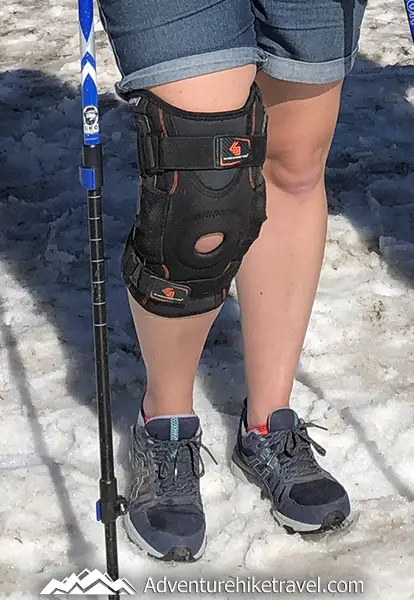
Build an ACL Support Group/Network
Sustaining an ACL injury can be an isolating and challenging experience, both physically and emotionally. To help overcome this challenge it helps to build an ACL support group or network. A support group can consist of friends, family members, or individuals who have gone through a similar experience. You can also seek out online communities and forums dedicated to ACL injuries and recovery. These groups can be an excellent resource for being able to ask questions, find out information, get advice, and be able to connect with others who have or are going through a similar journey.
Being part of an ACL support group can help you stay motivated, reduce anxiety and stress, and increase your confidence and resilience as you navigate the challenges of recovery. Remember that recovery is a journey, and having a supportive network by your side can make all the difference.
On Instagram, I started following the ACL Recovery Club. This was really helpful and inspiring seeing so many other people's journeys to recovery after ACL surgery: https://www.instagram.com/acl_recovery_club/
But my main support group was family. My mom was with me every step of the way taking me to doctor appointments, and physical therapy and went on lots of walks with me when I was walking at the speed of a turtle. My dad went on lots of easy river hikes with me while I was recovering and working on regaining strength too.
Then about 4 months after I tore my ACL snowboarding my brother tore his ACL dirt biking. We naturally became a support group to each other. Since I was ahead of him in recovery, I was able to give him tips and advice and we kept each other accountable for doing our physical therapy exercises. We would send a text and make sure we did all of our PT each day and when we were allowed to start going on hikes again we would go hiking together on easy flat trails on weekends and work on training up for more difficult hikes.
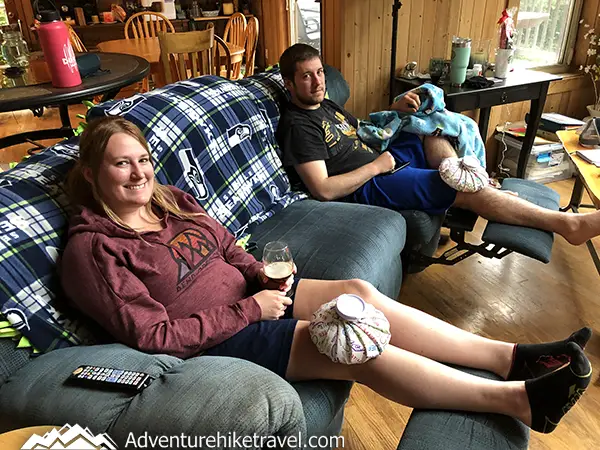
Additional Tips and Tricks For Hiking and Backpacking After ACL Surgery
Do Weight Training To Build Back Leg Muscle That Supports The Knee
Weight training can be a great way to build back the leg muscle that supports the knee joint that you may have lost with your ACL injury. I picked up a Rubber Coated Hex Dumbbell Set to do weight training to help me strengthen the muscles in my leg to help me get back to hiking again after having ACL reconstruction surgery. Shop on Amazon: Click Here. After I was farther along with my physical therapy having the progression of dumbells to do squats and lunges with was extremely helpful.
Strengthening the muscles in the legs that support the knee helps reduce the load on the knee joint during hiking, making it easier to hike with less pain. Exercises that target the quadriceps, hamstrings, and glutes are especially beneficial for building leg strength. Remember to consult with your doctor or physical therapist before beginning any weight training regimen to ensure that the exercises are appropriate for your specific injury and level of fitness. A physical therapist can also provide guidance on proper form and technique to prevent further injury.
Shop on Amazon: Click Here
Exercise and Train With Pack Weight At Home To Prep For The Trail
Training with pack weight at home can be a great way to prepare for hiking after ACL reconstruction surgery. This type of training can help you build endurance, strengthen your muscles, and get your body accustomed to carrying a pack. After talking with my physical therapist and once they gave me the go-ahead to start training with pack weight, I started walking every day with a weighted backpack. I gradually increased the weight in my pack and the length of time I walked each day.
Start with shorter training sessions and gradually increase the duration and intensity over time. By exercising and training with pack weight at home, you can build the strength and endurance needed to enjoy hiking after ACL reconstruction surgery.
Wear Quality Hiking Shoes or Hiking Boots While Hiking
After having ACL reconstruction surgery done on my knee, the last thing I wanted to do was slip and take a fall. Having quality hiking shoes or hiking boots is a must for hiking again after ACL reconstruction surgery. Good hiking shoes need to provide the necessary support, traction, and protection for your feet and ankles while hiking on many different terrains.
Look for shoes with sturdy ankle support and a wide base for stability that also have good traction to prevent slipping on uneven surfaces. By wearing quality hiking shoes or hiking boots, you can reduce the risk of slipping and reinjuring your knee while hiking. Even normal day-to-day I now often wear trail runners because I do not want to slip and fall after having had surgery on my knee. Having shoes with great traction even during daily life is highly important to me now post ACL surgery.
Blog posts You may be interested in
Try to Reduce Your Pack Weight When Backpacking
After having my own ACL reconstruction surgery I have made it a priority to cut down on pack weight when backpacking. Reducing your pack weight can be a simple effective way to reduce the load on your knees when backpacking after ACL surgery. The weight of a heavy pack adds extra stress to the knee joint, increasing the risk of pain and injury. Carefully select the gear that you choose to bring on your backpacking trip. Leave unnecessary items behind.
Before injuring my knees my pack was heavy, maybe 44-48 pounds, depending on how many days I was planning on hiking and how much food I was bringing. Now feeling how much pressure a heavy pack puts on my knees on the downhill, I am drastically working on upgrading my old heavy gear to newer lighter gear. Just by buying a new sleeping bag and switching to a lighter bear can I have been able to shave 5 pounds off my base pack weight and am looking for even more ways to drastically lighten my pack. Reducing your pack weight is the best way to help take the stress off your knees when you are backpacking.
Take Breaks During Your Hike
Taking breaks while hiking is super important after ACL surgery. It's essential to listen to your body and to rest when needed. Hiking is not a race, and it's important to pace yourself and take breaks when you feel tired or notice any pain or discomfort in your knee. You do not want to damage your knee by pushing yourself too hard.
Taking regular breaks can also help prevent fatigue and reduce the risk of further injury. Make sure to bring plenty of water and snacks, and take advantage of scenic viewpoints or rest areas to give your body a break. Additionally, don't forget to stretch and move around during breaks to keep your muscles loose and prevent stiffness. Remember to prioritize your safety and health and take care to not re-injure yourself.
Try to Reduce Your Own Body Weight If You Are Overweight
If you are overweight, reducing your body weight can be an effective way to reduce the load on your knees during hiking after ACL reconstruction surgery. Excess weight can put additional stress on the knee joint, increasing the risk of pain and injury. This is one thing I am still working on for myself!
Take Ibuprofen After Your Hike to Help Reduce Inflammation and Pain in Your Knee
While taking medication should always be discussed with your healthcare provider, taking ibuprofen after your hike can help reduce inflammation and pain in your knee. This can be especially helpful if you notice any soreness or discomfort after your hike. However, it's important to follow the recommended dosage and avoid exceeding the daily limit. It's also crucial to understand that medication should not be relied upon as a substitute for proper rest and recovery.
If you experience persistent or worsening pain, it's essential to seek medical attention to rule out any potential issues. Remember to prioritize your safety and health during any physical activity, including hiking, and always consult with your healthcare provider before taking any medication.
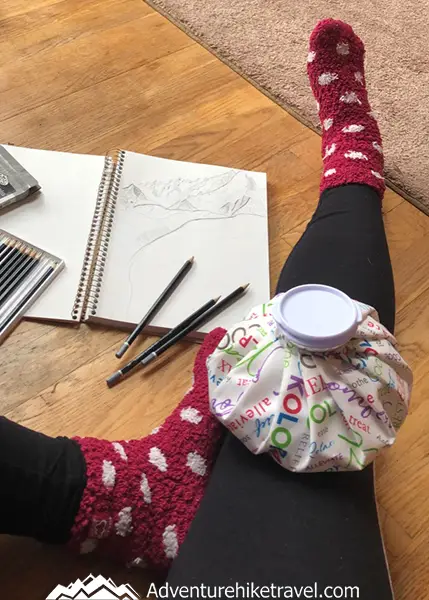
Ice Your Knee After Every Hike
ICE, ICE, ICE! I cannot stress enough how important icing your knee is. Hiking again after having ACL reconstructive surgery is going to be painful. As you continue to heal and improve you will have less and less swelling and pain but getting back to pre-ACL injury shape again is going to be tough. It's highly important to ice after every hike to take care of your knee to reduce inflammation and prevent further injury after ACL reconstruction surgery. One effective method is to ice your knee for 20 minutes after every hike. Ice helps to reduce swelling, numb pain, and decrease inflammation around the knee joint.
When I was cleared by my physical therapist and doctor to start hiking again after ACL surgery I would bring a mini cooler filled with ice and ice packs in the car. Shop on Amazon. After finishing my hike I would immediately grab an ice pack out of the mini cooler in my car and ice my knee to try and help prevent swelling.
When I would get home I would put on my Knee Ice Pack Wrap, that thing was absolutely amazing! You can find the knee Ice pack wrap that I used on Amazon Click Here. By icing your knee after every hike, you can help reduce inflammation and pain, and protect your knee from further damage.
Shop on Amazon:
Shop on Amazon:
Shop on Amazon:
Shop on Amazon:
After Hiking, Take a Hot Shower to Loosen Your Sore Muscles
Once you get back into hiking after your ACL reconstruction surgery after a long or even short hike, your muscles may feel sore, fatigued, and tight, which can definitely add to the pain and discomfort around your knee. Taking a hot shower can help loosen your sore muscles. The warm water can also increase blood flow and circulation to the affected area, promoting healing and reducing muscle soreness and pain around your knee.
Stretch Before and After The Hike
Stretching before and after hiking is super important for hikers that have had ACL surgery. Stretching helps prepare your body for physical activity and helps prevent injury. Before starting your hike, take a few minutes to stretch your muscles, especially your legs, and knees. Focus on stretching your quadriceps, hamstrings, and calf muscles. These muscles all help support your knee. Hold each stretch for at least 15-30 seconds, and remember not to push yourself too hard.
Stretching can also help warm up your muscles, increasing blood flow to the affected area and reducing the risk of injury. After your hike, make sure to stretch again to help prevent muscle soreness and tightness. Stretching after your hike feels good and can help improve your flexibility, and range of motion, and help reduce muscle tension in all those muscles that support your knee. By incorporating stretching into your hiking routine, you can improve your overall mobility, reduce your risk of injury, and protect your knee during your outdoor activities.
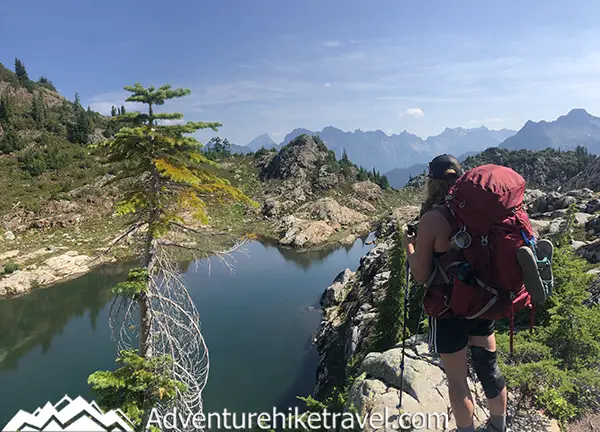
Hiking after ACL surgery is challenging but it is definitely satisfying to get back into the mountains again. I hope that by sharing my own ACL story and some of the tips and tricks that I learned along the way can help you have your own safe and successful return to trail.
Remember to consult with your doctor and physical therapist before returning to any physical activity after ACL surgery, and to take things slow and steady. With patience, perseverance, and the right tools and resources, you can overcome the challenges of ACL surgery and return to the trail stronger and more resilient than ever before.
Wishing you the best! Happy Trails!
Other Blog Posts You May Like:
5 Reasons to Buy LOWA Women’s Renegade GTX Mid Hiking Boots
12 Years of Hiking with Meindl Boots: The Ultimate Review
The Ultimate Guide to Backpacking Lake Ingalls and Headlight Basin in Washington State
85 Hiking Quotes That Will Inspire You To Get Outside
High Rock Lookout – Hiking in Gifford Pinchot National Forest
50 Inspirational Hiking Quotes To Inspire You To Get Outdoors!
35 Great Trail Running Shoes for Women
35 Great Trail Running Shoes for Men
Backpacking Upper Lena Lake – Olympic National Park
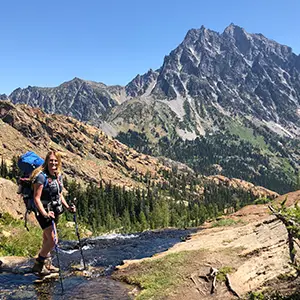
Want To Fill Your Life With Adventure?
Join our newsletter for an adrenaline-fueled journey! Receive exclusive updates on travel tips, gear reviews, epic hikes, captivating stories, and inspiration to turn your dreams into reality.
Don't just dream it, live it! Get Out There!


